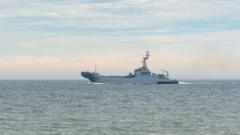NATO has officially launched a new mission to bolster surveillance efforts in the Baltic Sea, aimed at protecting essential undersea cables that have faced severe damage over the past year. The initiative, called "Baltic Sentry," was announced by NATO chief Mark Rutte during a recent summit held in Helsinki, which was attended by representatives from all Baltic Sea NATO member countries, including Finland, Estonia, Denmark, Germany, Latvia, Lithuania, Poland, and Sweden.
The mission will see an enhancement in the deployment of patrol aircraft, warships, and drones in the region. Although Russia was not specifically identified as a perpetrator of the cable damage, Rutte underscored the need for increased monitoring of what he termed Moscow's "shadow fleet," which operates ships of unclear ownership that are thought to transport embargoed oil products. The relationship between NATO nations and Russia has soured significantly following Russia's invasion of Ukraine in February 2022.
"There is reason for grave concern," Rutte stated, emphasizing that NATO will respond firmly to such infrastructural accidents. This includes more aggressive boarding of suspicious vessels and potentially their seizure. The NATO chief refrained from disclosing specific details regarding the number of assets involved in the Baltic Sentry mission, citing the need to maintain strategic discretion.
Undersea infrastructure plays a critical role in powering the economy, with over 95% of global internet traffic transmitted through these cables. Rutte highlighted the importance of the network, noting that approximately 1.3 million kilometers (about 800,000 miles) of undersea cables facilitate around $10 trillion worth of financial transactions daily. In a post on social media platform X, Rutte affirmed NATO's commitment to safeguarding vital infrastructure.
Recent months have seen a surge in unexplained incidents concerning undersea infrastructure in the Baltic region. The latest incident involved an electricity cable connecting Finland and Estonia, which was severed at the end of December. The Finnish coast guard had previously boarded the oil tanker Eagle S, which was under the Cook Islands flag, as it was allegedly threatening to damage another cable and a gas pipeline between the two nations.
In the wake of these incidents, the frequency of damage to underwater infrastructure has raised doubts regarding whether these events can still be regarded as coincidental. Estonia's Foreign Minister Margus Tsahkna mentioned in December that such occurrences had become so common that they could not simply be attributed to "accident" or "poor seamanship." Similarly, Swedish Prime Minister Ulf Kristersson emphasized the peculiar nature of these incidents while refraining from direct accusations, insisting that hostile intentions could not be disregarded.
In summary, NATO's "Baltic Sentry" mission is a proactive measure in response to the rising threats to undersea infrastructure, heightening surveillance capabilities in a region that has seen worrying instances of cable damage and infrastructure breaches.




















